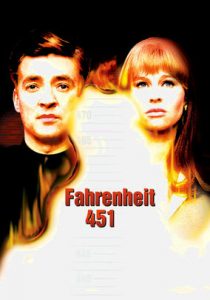Fahrenheit 451-1966
Director Francois Truffaut
Starring Oskar Werner, Julie Christie, Cyril Cusack
Scott’s Review #728
Reviewed February 26, 2018
Grade: B+
Based upon the famous and fantastic classic 1953 novel Fahrenheit 451 by Ray Bradbury, the film adaptation is futuristic and dystopian.
Directed by French filmmaker Francois Truffaut and starring Julie Christie, the “it” girl of the late 1960s, the film succeeds as an incredible, new wave, edgy, progressive hybrid. Various elements aid in making the film seem set in the future, all with hints of the great director Alfred Hitchcock sprinkled in the mix.
Indeed, the novel is superior, but Fahrenheit 451 is a worthy watch if only for Christie alone.
Christie plays a dual role as Clarisse, a young schoolteacher with progressive and forbidden views, and Linda, the vastly different spoiled wife of the central character, Guy Montag, played by German actor Oskar Werner.
The trio exists in a futuristic world where a totalitarian government has banned all literature, deeming it insufficient for society. A force called Firemen, where Guy works, can search anyone anytime and burn all books as needed.
Clarisse and Guy begin questioning the government’s motivations as Guy stashes a copy of Charles Dickens’s David Copperfield, which puts the pair in danger.
What I like most about the film is its mysterious and foreboding concept, which is downright scary. What if books were suddenly non-existent and forbidden?
Like the novel, the film references luscious and brilliant literary works of art, so much so that the viewer will undoubtedly feel how this reality would be devastating.
As with similar titles such as “1984” and “Brave New World,” the futuristic world and the “Big Brother is watching” theme is critical to its success.
Director Truffaut, an ardent fan of the master Hitchcock, seamlessly incorporates elements of suspense and key “Hitchcockian” moments, specifically with the musical score.
Truffaut used Bernard Hermann, the same composer Hitchcock used in 1966’s Torn Curtain, but more importantly, the prevalence of strings is reminiscent of classics like Psycho and Vertigo.
A fight scene behind frosted glass so that only shadows can be seen is a direct homage to Hitchcock’s famous style.
To accompany the Hitchcock comparisons, an exciting film anecdote is that legendary Hitchcock superstar Tippi Hedren was desired for the central dual role. Still, he would not allow it since she and Hitchcock were embroiled in a feud then, and she was under contract.
The possibilities this would have presented are endless. But alas, Christie is no slouch as the film’s female star.
Christie deserves significant kudos. She plays both characters to the hilt and is one of the film’s best aspects.
Anyone who has read Bradbury’s novel will understand how the character of Clarisse is expanded in the film. One wonders if this was done to showcase more of Christie.
Regardless, Clarisse and Linda’s characters are entirely different from each other, and the actress is superb. Unfortunately, this film is not among Christie’s most remembered films.
My main detraction of Fahrenheit 451, the film, is that having recently read the novel, there is no comparison, as the book is far superior. However, the film is perfect and contains some beautiful visuals and imagery.
So few times can a film usurp the beauties of the written word, and how ironic given the subject matter of the destruction of books.
Fahrenheit 451 (1966) is a stylistic, artistic film with a relaxed vibe. It features a tremendous performance from one of the ’60’s most considerable talents.
The film initially received fair to middling reviews and is now largely forgotten, but it’s nice to take down from the dusty old shelves of the Hollywood obscure now and then.
